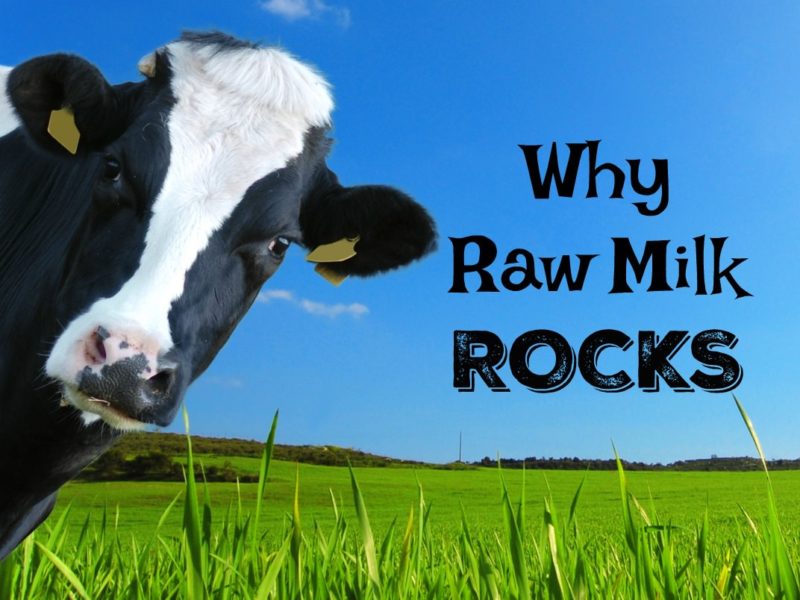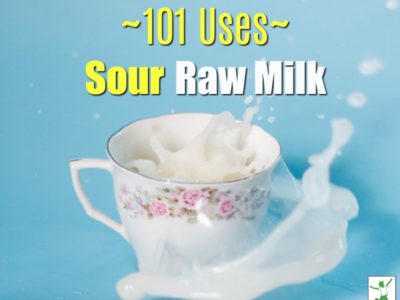Table of Contents[Hide][Show]

My family and I have been drinking raw milk for almost two decades. It is the only type of milk my three children have ever known. They also have never had antibiotics nor do they suffer from any allergies, asthma or other auto-immune ailments. I attribute this in large part to the healthy, unprocessed milk they have consumed their entire lives. This approach is in accordance with the child-rearing practices of numerous degenerative disease-free ancestral cultures.
Forbes magazine has identified raw milk as one of the healthiest foods on the planet. Such high profile media is an indication that this most traditional of foods is increasingly displacing factory milk which triggers allergies and lactose intolerance for many. Contrary to popular belief, raw milk is one of the safest foods to consume. This is due to the benefits of modern technology including flash refrigeration and sterilized, automatic milking machines which have reduced the risk of foodborne pathogens to a minimal level.
Raw milk is one of the most beneficial foods children can consume during their growing years, strengthening their immune system for life. The Journal of Allergy and Clinical Immunology published a study which found that “exposure to farm milk in early life and consumption of raw farm milk have been associated with a reduced asthma and atopy risk, and it has been suggested that this protection might be mediated through receptors of the innate immune system.”
Raw Milk Nutrition
Not all raw milk is created equally. In other words, the living conditions of the dairy cows, what they eat, and the drugs (if any) they are subjected to can all greatly affect not just whether the raw milk is safe to consume, but also whether it is actually nutritious.
Raw milk produced in the cities in the nineteenth and early twentieth centuries in America was so low in nutrition that it was actually bluish in color. This led the unscrupulous dairy owners to add chalk to the milk to fool customers by making it appear white. The reason for the low nutrition in this urban raw milk was that the cows were not grazing on green pasture. Instead, they were eating leftover distillery mash while being confined 24/7 in filthy, manure-ridden conditions. (source)
When cows are eating green grass, not subjected to hormones and other drugs, and the milk is procured in a clean environment, raw milk is one of the most nutrient-dense foods to consume. In fact, early humans recognized the superior nutrient of raw milk. It sustained them for millennia via dairy herds until the advent of agriculture added additional foodways allowing the nomadic existence of humankind to end (source).
Is Raw Milk Good for You?
We’ve all seen the ads with celebrities and their white mustaches proclaiming that”milk does a body good”. Of course, these ads are only referring to pasteurized milk.
But is this true when it comes to raw milk?
When raw milk is produced from contented, healthy cows grazing on green grass, then the nutrition is unparalleled. In fact, properly produced raw milk exceeds the nutrition and benefits of pasteurized versions by a country mile.
Fats, carbohydrates, and protein are presented to the body in a perfectly balanced ratio. In addition, raw milk has such a rich array of enzymes and probiotics that it basically digests itself with little help needed by the digestive process. No wonder grass-fed raw milk was used extensively by the forerunner of today’s Mayo Clinic to bring sick patients back to health!
Raw Milk vs Pasteurized Milk
Pasteurization completely destroys all the probiotics and enzymes in raw milk making it much more difficult to digest. Enzyme-less milk even triggers symptoms of lactose intolerance in some people. Why? Because lactase, the enzyme to digest the lactose, has been destroyed! This leaves an individual’s digestive process to make the enzyme, and if the person has trouble with this for whatever reason, bloating and other uncomfortable symptoms emerge.
Raw milk contains up to two-thirds more of vitamins A, D and E than heat-treated milk. Vitamin C loss from heat pasteurization is usually 50% or more!
The destructive nature of pasteurization to the nutrients in milk also results in the water-soluble vitamins becoming up to 80% less bioavailable. Some water-soluble nutrients are completely destroyed by pasteurization including B6 and B12. Ironically, most people are deficient in these nutrients even if plenty of pasteurized dairy is consumed. (source)
Raw milk contains lipase which allows efficient fat metabolism and proper absorption of vitamins A and D. The dairy industry adds synthetic vitamin D to pasteurized milk to compensate for this loss.
Ultrapasteurized (UHT) Milk Worse than Pasteurized!
Extremely high temperatures are utilized to produce ultrapasteurized milk, also referred to as UHT milk. This violent processing damages fragile milk proteins in such a complete manner that the enzymes the body produces to digest them no longer work. Enzymes and proteins are supposed to fit together like puzzle pieces. But, with UHT milk, the proteins are damaged to the point where this is no longer possible.
Undigested proteins find their way through perforations in the gut into the bloodstream, aka “leaky gut” syndrome. These damaged proteins not recognized by the body are identified instead as foreign which results in the body mounting an immune response. When this happens, allergies, asthma, eczema and other symptoms of autoimmune disorders are experienced.
Essentially, UHT is sterilized and has absolutely no benefits! It is in the refrigeration section of the store to fool consumers into thinking it is somehow “fresh”. In reality, it could actually sit on the shelf for months. There is no way that it can be considered healthy even if it is labeled USDA organic.
My experiences with drinking organic UHT milk were not good. I remember when my first child was nursing, I drank a lot of Organic Valley ultrapasteurized milk. My son spit up so badly during that time that there was some concern that he had a reflux disorder. Remarkably but not surprisingly, when I stopped drinking the Organic Valley milk, his reflux problem resolved. I have no doubt that if I had continued drinking this milk and had weaned my son onto it that he would undoubtedly have a milk allergy today. Fortunately, I wised up in time to get off that poison!
Toxins in UHT Milk
It’s interesting that many consumers feel that buying organic UHT milk will expose them to fewer toxins. This is no guarantee! Processors of organic UHT milk heat it to the required 270 °F/ 132 °C AFTER the milk is already in the aseptic package or plastic jug!
Another option, which just as bad, is to fill the package or jug with boiling hot milk that has not yet cooled down!
This type of processing releases high levels of endocrine-disrupting phthalates (BPA and others) used in the packaging. And, these chemicals get into the milk! Most everyone now knows never to heat food in a microwave with plastic wrap on top for this very reason. It’s a shame more people aren’t aware of the tremendous endocrine-disrupting potential of drinking ultrapasteurized milk even if it is labeled organic.
Calcium in Raw Milk
Calcium is a very important mineral for bone health. It has caught on so much in America, in fact, that nearly all foods including orange juice and boxed cereals are artificially fortified with it.
Milk is lauded as being loaded with natural calcium. But the truth is that pasteurization makes calcium and other minerals less available. Complete destruction of phosphatase is one method of testing to see if milk has been adequately pasteurized. Phosphatase is essential for the absorption of calcium!
Raw milk not only has calcium, but it contains it in the form needed for absorption by the body. What good is consuming a nutrient that is not bioavailable? Such is the difference between calcium in pasteurized versus raw milk.
I have a friend with osteoporosis who was eating large amounts of pasteurized, organic milk and yogurt to try and resolve this health crisis. Despite eating all this organic processed dairy, her condition continued to worsen. As soon as she switched to raw milk, however, the deterioration stopped and she even started building bone again!
Nutrition of Raw Milk is Unparalleled
With all of these problems, nutrient destruction and even toxins in pasteurized and ultrapasteurized milk, wouldn’t it be better to just drink milk in its natural form? That is – raw! This way, you get all these nutrients in their complete and natural state with the enzymes present to adequately digest and absorb them. And, you won’t get any toxins inadvertently added via the factory processing such as what happens with UHT milk.
Are There Any Dangers of Raw Milk?
As alluded to above, raw milk that is produced from unhealthy cows can be harmful and even dangerous food to consume. The bluish-white raw milk from the early days of the Industrial Revolution in America made many people sick with young children dying in some cases.
This dirty raw milk produced from confined and sick cows eating distillery grains is the reason why pasteurized milk started to be favored in the early twentieth century. This despite the fact that farm-fresh raw milk continued to be very safe. Rich people in the city had this milk brought in for their children eschewing the dangerous raw milk produced in the town. Eventually, pasteurized milk became the only game in town edging out even safely produced raw milk.
The advent of modern refrigeration and technology has allowed raw milk to enjoy a resurgence in popularity. This means that the superior nutrition of raw milk can be enjoyed safely when procured from a grass-fed farm that is clean and that follows proper production protocols.
Hence, enjoy the benefits of raw milk and the superior nutrition it imparts, but be a savvy customer. Check out the farm that you will be purchasing from and make sure it is clean and that the cows have access to pasture.
There is no substitute for being an informed consumer of raw milk!
Transitioning to Unpasteurized (Raw) Milk from Pasteurized
If the benefits of raw milk have you convinced to ditch the processed store versions and go for the Real Thing, note that it is wise to do so slowly. Raw milk is loaded with beneficial probiotics which can give some people a cleansing reaction. While a beneficial thing, it can be uncomfortable until the body adjusts in a positive manner.
Cleansing symptoms may take the form of loose stools, headache, or fatigue as pathogenic bacteria and yeasts are eliminated from the gut environment and their toxins removed from the body by the excretory system.
A suggested transition protocol would be to start with an ounce or two per day or every other day. Gradually work your way up over a period of a week or two to the amount of milk you would normally consume.
Raw Milk Health Benefits
Popular Posts:
- Antimicrobial Resistance Genes in Raw Milk?
- How to Make REAL Buttermilk (4 Easy Methods)
- Supplementing with Colostrum
- Benefits of Sheep Milk Compared with Other Types of Dairy
- Cold Pressed Milk: So Good, You’ll Think it’s Raw?
- Healthy Cheese: 5 Things You MUST Ask Before Buying
- What Does Raw Milk Taste Like?
- Study: Lowfat and Skim Milk Drinking Kids Are Fattest
- Young Raw Milk Drinkers Less Prone to Allergies
- Raw Milk Significantly Eases Childbirth Pain
- Raw Milk Solves Low Milk Supply for Nursing Mom
- The French Paradox and Raw Milk
- Lyme Disease and The Milk Cure
- Advantages of Cow Milk over Goat Milk (and vice versa)
- Why Skim Milk Will Make You Fat (and Give You Heart Disease!)








Leave a Reply